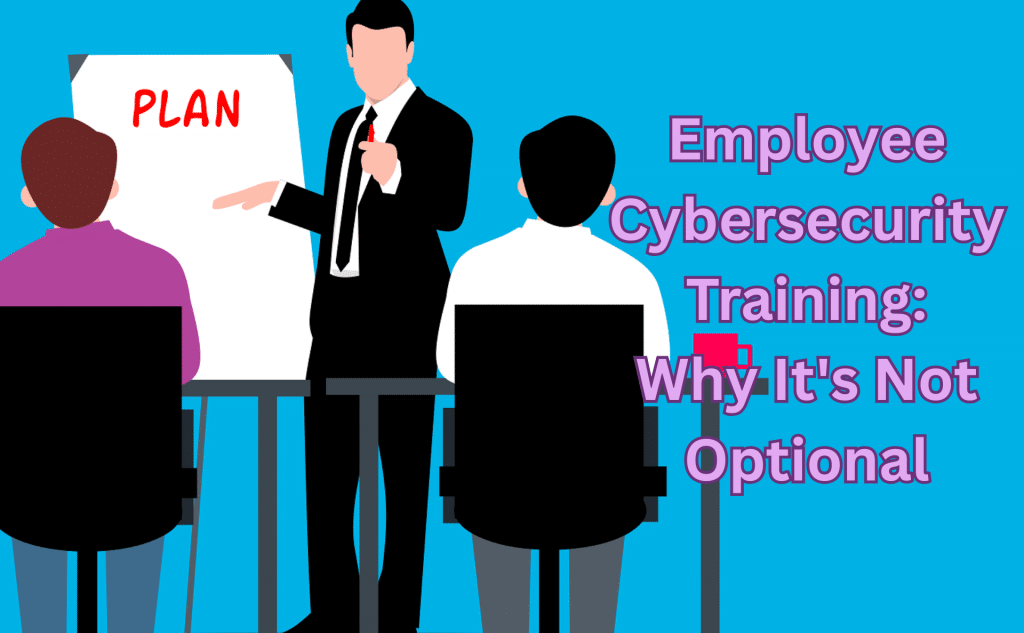Various cybersecurity threats are evolving and increasing in numbers at a very fast pace. Recently, the popularity of AI has also improved the way in which hackers are trying to steal personal and business information. Hence, companies are exposed to emerging threats such as phishing scams, ransomware, and data breaches, costing a company millions. Most of these companies invest in firewalls and other advanced security tools, but one element of defense is usually ignored: human factor. Even the best systems cannot succeed without effective employee cybersecurity training.

Employee Cybersecurity Training Why It’s Not Optional
Why Employees Can be the Weakest or the Strongest Link in Your Cybersecurity Protocol
Aside from the active attempts to infiltrate a network system by the hackers, most entry points for cyberattacks start with a human error. One click on a malicious email can open the gateway to hackers. Industry reports say that phishing is the most widespread attack method, and the first-line attack targets are employees.
However, on the flip side, your greatest defense can also be employees. A knowledgeable team can help detect suspicious emails and secure confidential information. Additionally, they would know best not to download dangerous files. Thus, awareness from employee cybersecurity training is the factor that turns employees into assets.
The High Cost of Ignoring Training
Employee cybersecurity training is usually costly. However, without it, the risk that businesses face can be more expensive. This will include financial loss from ransomware or fraud as well as criminal and civil charges from data security laws. This is on top of the opportunity cost from operational downtime. Perhaps the most damaging thing is when these risks are multiplied by several departments or stores. This usually results in overwhelming losses. This becomes even more significant for small and mid-sized businesses as a single incident may put survival at stake.
What Effective Cybersecurity Training Looks Like
Employee cybersecurity training sessions are not created equal. To be effective, training must be practical, ongoing, interactive, and inclusive. It should be a catalyst in making cybersecurity hygiene a part of workplace culture.
Practical
This means that the training concentrates on real-life situations. This includes detecting phishing or coming up with a good password.
Ongoing
Cyber threats are many and evolve rapidly. As such, the training should not be a one-time event. Instead, it must be continuous as it is regular.
Interactive
In order to be effective, the knowledge transmitted must be retained. This is made easier if it involves exercises, simulations, and role-playing possible scenarios.
Inclusive
Everyone in the business must be involved in the training. This should range from interns up to executives or owners. This is because hackers have no preference in regard to targets as well.
Core Topics to Cover in Training
To gain resilience, employee cybersecurity training must discuss in detail the following:
- Phishing awareness – How to detect suspicious emails and links.
- Password hygiene – Use strong and distinct passwords and multi-factor authentication.
- Secure browsing – Not using insecure sites and downloads.
- Security of devices – The security of laptops, smartphones, and tablets.
- Data handling – Understanding how to deal with sensitive information of clients or companies.
- Response to incidents – What to do in case there is suspicion of a cyberattack.
These basics will mean that employees understand how to avoid and how to react to threats.
Creating a Security-First Culture
Cybersecurity is not only an IT problem, but also a business problem. Therefore, HR managers and leaders have an important role to play in influencing the workplace culture. To motivate employees to be serious about security, it begins with making sure that executives are following cybersecurity protocols as well. Additionally, reporting of suspicious activity must be encouraged and rewarded. In the same vein, making it part of the onboarding process is imperative so that new employees take in the protocol from day 1 in the company. Once security is integrated into the daily process, employees will treat it as their second duty and not an additional activity.
The Role of Technology in Training
Training and education should be accompanied by the right tools to promote safe behavior. As an example, simulated phishing tests assess progress, and security awareness platforms provide continuous lessons. Collaboration with providers such as EB Solution assists the companies in integrating the training of the employees with technical protection. Here at EB Solution, we do not just provide a secure IT infrastructure but also help businesses establish resilient cybersecurity practices.
Why Canadian Businesses Must Act Now
Canada has a tight set of rules regarding data protection, with penalties likely to be imposed in case of violation. Meanwhile, small, and medium-sized businesses without dedicated security teams are increasingly targeted by cybercriminals. This is where a reliable managed IT services provider such as EB Solution can help. Partnering with experienced professionals provides you with IT solutions for your small to medium business needs without the expense and hassle.
